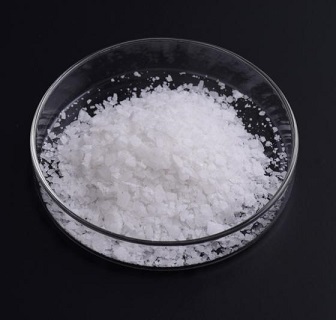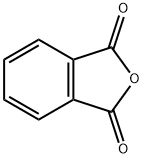-
外観
白色, 結晶〜結晶性粉末又はフレーク
-
性質
分子式はC8H4O3で分子量が148.12の純白針状結晶です。外観は結晶性の粉末またはフレーク状で、わずかに刺激臭があります。密度は1.527g/cm3、融点が130.8℃、沸点が284.5℃、引火点が151.7℃、発火点は570℃です。アルコールに可溶で、エーテル、熱湯にややわずかに溶解します。
-
反応
酸塩基反応の指示薬として広く用いられているフェノールフタレインはフタル酸と2分子のフェノールを分子間で脱水反応して得られます。
また1級アミン基の保護基 (有機合成で反応性の高い官能基を一時的に保護するための官能基) としても用いられます。
-
溶解性
水に微溶 (0.6g/100ml水, 25℃)。エタノール, メタノール, アセトンに可溶。エタノールにやや溶けにくく、水にほとんど溶けない。
-
用途
フタル酸系可塑剤原料、 塗料、ポリエステル樹脂、塗料中間体(フタルイミド、フタロニトリル、O-ベンゾイル、安息香酸など)、テレフタル酸、医薬品、香料
-
用途
可塑剤、樹脂塗料
-
解説
無水フタル酸,フタル酸を加熱すると容易に脱水して無水物が得られる.工業的には,ナフタレンやo-キシレンを酸化バナジウム触媒の存在下400~460 ℃ で空気酸化して大量に合成される.昇華しやすい結晶で,融点131~132 ℃,沸点295 ℃.d441.527.アルコール類,ベンゼンなどに可溶,また熱水には溶けてフタル酸になる.可塑剤やアルキド樹脂の原料として,またフタロシアニン染料,そのほかの染料・顔料の中間物として用いられる.眼の粘膜を刺激することがある.
-
説明
Phthalic anhydride is the organic compound with the formula C6H4(CO)2O. It is the anhydride of phthalic acid. This colourless solid is an important industrial chemical, especially for the large-scale production of plasticizers for plastics.

Phthalic anhydride is an important chemical intermediate in the plastics industry from which are derived numerous phthalate esters that function as plasticizers in synthetic resins. Phthalic anhydride itself is used as a monomer for synthetic resins such as glyptal, the alkyd resins, and the polyester resins.
Phthalic anhydride is also used as a precursor of anthraquinone, phthalein, rhodamine, phthalocyanine, fluorescein, and xanthene dyes.
Phthalic anhydride is used in the synthesis of primary amines, the agricultural fungicide phaltan, and thalidomide. Other reactions with phthalic anhydride yield phenolphthalein, benzoic acid, phthalylsulfathiazole (an intestinal antimicrobial agent), and orthophthalic acid.
-
化学的特性
Phthalic Anhydride is moderately flammable, white solid (flake) or a clear, colorless, mobile liquid (molten) Characteristic, acrid, choking odor. It is very slightly soluble in H2O, soluble in alcohol, and slightly soluble in ether.
-
物理的性質
Colorless to pale cream crystals with a characteristic, choking odor. Moisture sensitive. Odor
threshold concentration is 53 ppb (quoted, Amoore and Hautala, 1983).
-
定義
ChEBI: Phthalic anhydride is the cyclic dicarboxylic anhydride that is the anhydride of phthalic acid. It has a role as an allergen. It is a cyclic dicarboxylic anhydride and a member of 2-benzofurans.
-
製造方法
The most important modifying component used in the
manufacture of linear unsaturated polyesters is phthalic anhydride. The
anhydride is generally obtained by the oxidation of o-xylene:

The reaction is carried out in the vapour phase by passing a mixture of
o-xylene and air over a catalyst such as vanadium pentoxide supported on
silica and promoted with titanium dioxide at about 400??C. The exit gases are
cooled and the phthalic anhydride is collected and purified by distillation
under reduced pressure.
-
一般的な説明
A colorless to white lustrous solid in the form of needles with a mild distinctive odor. Moderately toxic by inhalation or ingestion and a skin irritant. Melting point 64°F Flash point 305°F. Forms a corrosive solution when mixed with water. Used in the manufacture of materials such as artificial resins.
-
空気と水の反応
Reacts, usually slowly with water to form phthalic acid and heat [Merck 11th ed. 1989]. The phthalic acid is somewhat soluble in water.
-
反応プロフィール
Phthalic anhydride reacts exothermically with water. The reactions are sometimes slow, but can become violent when local heating accelerates their rate. Acids accelerate the reaction with water. Incompatible with acids, strong oxidizing agents, alcohols, amines, and bases. Undergoes exothmeric nitration with fuming nitric acid-sulfuric acid and may give mixtures of the potentially explosive phthaloyl nitrates or nitrites or their nitro derivatives [Chem. & Ind. 20:790. 1972]. Phthalic anhydride reacts violently with CuO at elevated temperatures [Park, Chang-Man, Richard J. Sheehan. hthalic Acids and Other Benzenepolycarboxylic Acids Kirk-Othmer Encyclopedia of Chemical Technology. John Wiley & Sons, Inc. 2005]. Mixtures of Phthalic anhydride and anhydrous CO2 explode violently if heated [eaflet No. 5, Inst. of Chem., London, 1940].
-
健康ハザード
Solid irritates skin and eyes, causing coughing and sneezing. Liquid causes severe thermal burns.
-
火災危険
Combustible material: may burn but does not ignite readily. Substance will react with water (some violently) releasing flammable, toxic or corrosive gases and runoff. When heated, vapors may form explosive mixtures with air: indoors, outdoors and sewers explosion hazards. Most vapors are heavier than air. They will spread along ground and collect in low or confined areas (sewers, basements, tanks). Vapors may travel to source of ignition and flash back. Contact with metals may evolve flammable hydrogen gas. Containers may explode when heated or if contaminated with water.
-
有害性
フタル酸系可塑剤の有害性
1990年代から2000年代前半にかけて、塩化ビニルなどに使用されているフタル酸系可塑剤の人体や環境への影響が問題視されたことがありました。現在では、フタル酸系可塑剤は、医療用途を含め、半世紀以上にわたり世界中で使用されており、人間や環境に対するリスクは問題ないレベルであり、現在の状況に加えてさらなる規制や管理の必要性はないとされています。
-
化学性质
多塩基酸の一つで,アルキド樹脂の合成に用いられる。
-
使用用途
無水フタル酸は、プラスチックを柔らかくするための可塑剤であるフタル酸ジオクチル、フタル酸ジブチルなどのフタル酸ジエステルの製造用原料として利用されています。この他、、合成樹脂塗料原料である顔料やアルキド樹脂、、、エオシンなどの染料、医薬の合成原料も用途の1つです。
これらは、主に、住宅の壁紙や床材電線の被覆、家具等の塩ビレザーなどの原料として幅広く使用されています。
-
応用例(製薬)
Phthalic anhydride reacted with cellulose acetate forms cellulose acetate phthalate (CAP), a common enteric coating excipient that has also been shown to have antiviral activity. Phthalic anhydride is a degradation product of CAP.
-
接触アレルゲン
Phthalic anhydride is used in the manufacture of unsaturated
polyesters and as a curing agent for epoxy resins.
When used as a pigment, it can be responsible for sensitization
in ceramic workers. Phthalic anhydride per se is
not responsible for the sensitization to the resin used in
nail varnishes phthalic anhydride/trimellitic anhydride/
glycols copolymer.
-
安全性プロファイル
Poison by ingestion.
Experimental teratogenic effects. A
corrosive eye, skin , and mucous membrane
irritant. A common air contaminant.
Combustible when exposed to heat or flame; can react with oxidzing materials.
Moderate explosion hazard in the form of
dust when exposed to flame. The
production of ths material has caused many
industrial explosions. Mixtures with copper
oxide or sodium nitrite explode when
heated. Violent reaction with nitric acid +
sulfuric acid above 80℃. To fight fire, use
CO2, dry chemical. Used in plasticizers,
polyester resins, and alkyd resins, dyes, and
drugs. See also ANHYDRIDES.
-
職業ばく露
Phthalic anhydride is used in plasticizers; in the manufacture of phthaleins; benzoic acid; alkyd and polyester resins; synthetic indigo; and phthalic acid;which is used as a plasticizer for vinyl resins. To a lesser extent, it is used in the production of alizarin, dye, anthranilic acid; anthraquinone, diethyl phthalate; dimethyl phthalate; erythrosine, isophthalic acid; methylaniline, phenolphthalein, phthalamide, sulfathalidine, and terephthalic acid. It has also found uses as a pesticide intermediate.
-
製造方法
無水フタル酸は、硫酸などの脱水剤存在下でフタル酸を加熱し分子内脱水して得られます。工業的な量産には、触媒にを用いてまたはオルトキシレンを気相で酸化する手法が使われています。製造設備は、いずれの原料でも製造できるようになっていることがほとんどです。
製造方法は触媒の使用方法により、流動床法と固定床法に分けられますが、いずれの方法でも、反応、凝縮、蒸留の3つの主要工程から成り立っています。原料であるナフタレンまたはオルトキシレンを蒸発器で気化します。気化した原料を混合器で大過剰の空気と混合し、これを100~200℃に余熱します。
これを触媒が詰められた多管式の反応器に通すことで、空気中の酸素により原料のナフタレンまたはオルトキシレンが酸化されて無水フタル酸が生成します。
触媒は使用する原料によって違いはありますが、一般的にはシリカ、アルミナ、シリコンカーバイド、軽石などの担体にバナジウム系の触媒を付着させたものが用いられています。反応時の接触時間は0.1~0.5秒と言われています。
反応器の温度は、400~500℃で行われるのが基本です。得られた粗無水フタル酸を蒸留し、収率85%程度で無水フタル酸が得られます。
-
合成方法
ナフタレン酸化法,o-キシレン酸化法
-
輸送方法
UN2214 Phthalic anhydride with>.05 % maleic anhydride, Hazard class: 8; Labels: 8-Corrosive material.
-
純化方法
Distil the anhydride under reduced pressure. Purify it from the acid by extracting with hot CHCl3, filtering and evaporating. The residue is crystallised from CHCl3, CCl4 or *benzene, or sublimed. Fractionally crystallise it from its melt. Dry it under vacuum at 100o. [Saltiel J Am Chem Soc 108 2674 1986, Beilstein 17/11 V 253.]
-
不和合性
Dust forms an explosive mixture with air. Phthalic anhydride reacts exothermically with water. The reactions are sometimes slow, but can become violent when local heating accelerates their rate. Acids accelerate the reaction with water. Incompatible with acids, strong oxidizing agents, alcohols, amines, and bases. Converted to phthalic acid in hot water. Incompatible with oxidizers (chlorates, nitrates, peroxides, permanganates, perchlorates, chlorine, bromine, fluorine, etc.); contact may cause fires or explosions. Keep away from alkaline materials, strong bases, strong acids, oxoacids, epoxides. caustics, ammonia, amines, water. Reacts violently with copper oxide or sodium nitrite 1 heat.
-
廃棄物の処理
Use a licensed professional waste disposal service to dispose of this material. Dissolve or mix the material with a combustible solvent and burn in a chemical incinerator equipped with an afterburner and scrubber. All federal, state, and local environmental regulations must be observed. Consult with environmental regulatory agencies for guidance on acceptable disposal practices. Generators of waste containing this contaminant (≥100 kg/mo) must conform with EPA regulations governing storage, transportation, treatment, and waste disposal.





